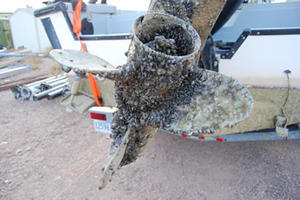Foreign invadersInvaders wreak havoc on U.S. ecosystems
In the decade since the 9/11 attacks, DHS’ focus on combatting terrorism has left some of its core agencies ill-equipped to perform its other missions, namely the Customs and Border Protection’s (CBP) ability to prevent invasive plants and insects from entering the United States and wreaking havoc on crops

Ukrainian Quagga mussels proliferate and cause waterway damage // Source: nps.gov
In the decade since the 9/11 attacks, DHS’ focus on combatting terrorism has left some of its core agencies ill-equipped to perform its other missions, namely the Customs and Border Protection’s (CBP) ability to prevent invasive plants and insects from entering the United States and wreaking havoc on crops.
“Everybody pays a price,” explained Mark Hoddle, an entomologist at the University of California, Riverside. “When we have an agricultural pest that comes in and establishes, it means growers have to apply more pesticides to control that pest. That increases environmental contamination; that means your food prices increase, so if you want to buy oranges or apples, you end up paying slightly more because management costs have increased.”
According to statistics from Oregon Public Broadcasting, more than 50,000 non-native plant and insect species have taken hold in the United States. Although most have been harmless, several have proven to be particularly troublesome.
For instance the mildly toxic yellow star thistle from Eurasia has taken hold, crowding out millions of acres of grass that cows graze on in the Western United States, severely affecting ranchers. Meanwhile Quagga mussels from Ukraine have grown rampant in many U.S. waterways causing billions of dollars in damage to boats, docks, and other property in addition to clogging pipes and impeding the flow of water.
Agriculture specialists argue that CBP has primarily dedicated its resources to finding and preventing illegal immigrants and terrorists from entering the country, leaving little to focus on keeping invasive species out.
A 2006 Government Accountability Office (GAO) report found that in 2003 more than 1,800 agricultural specialists were reassigned to DHS. This move left the borders unprotected against invasive plants, insects, and animals that have resulted in billions of dollars in crop damage and eradication programs.
The more than 1,800 agricultural specialists, originally under the jurisdiction of the Department of Agriculture’s Animal and Plant Health Inspection Service (APHIS), were transferred to CBP where they were asked to look for terrorists and weapons as well as plants and pests.
Officials say this move was highly disruptive culturally and did not make sense as agriculture inspectors trained to search for plants were now also identifying terrorists. By integrating customs and agricultural inspection duties under the same office, agriculture inspectors found themselves in CBP field offices alongside gun-wielding border agents.
Jeff Grode, the assistant director for emergency and domestic programs at APHIS, said the culture shock of suddenly being in the field in a very different environment was a massive culture shock.
“Anytime you have a change like that, there’s some disruption,” Grode said.
In addition senior officials involved with the transfer told GAO auditors that the reassignments were done quickly and without any coherent strategy, resulting in the seemingly random placement of inspectors.
Hoddle is currently working with researchers from the California Department of Food and Agriculture and academia to complete a study that examines invasive species over the last thirty years. This study will provide empirical evidence that indicates whether recent shifts in agriculture inspection strategy have proven to be a problem.
“We have a team that’s looking exactly at this issue to see what the invasion rates of exotic organisms into California have been over the last twenty-two years. This will include data before and after 9/11,” he said. “We should be able to run statistical tests to determine whether the invasion rates into California are significantly different before and after that time.”
Hoddle expects their work to be complete by the spring of 2012.
